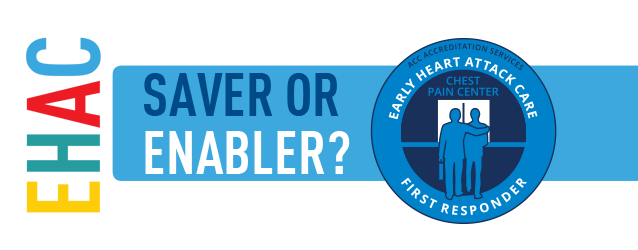EHAC Articles

Are you a Saver or an Enabler?
(This article was originally published in 2012, but this remains part of the core EHAC message)
The Bystander is perhaps the most important person in understanding what needs to be done when there is a person in our midst having a Heart Attack. Whether that Heart Attack Victim is a loved one or a stranger, if you are standing nearby, would you know what to do? Let us put ourselves in the shoes of the bystander and try to better understand the problem so that we know what actions will save a life.
There are three types of Heart Attack Presentations and you have to know how to help.
- There is the one that drops you dead and you have no chance at all to survive unless you can be defibrillated fast (chances are not that good). However, if the bystander knows how to perform Cardio Pulmonary Resuscitation - old or new CPR – there is a chance of survival.
- There is the second type of Heart Attack Presentation and this is a no brainer. The patient will appear very weak and sweating cold beads across their foreheads. The person here is most likely experiencing Severe Pain across the Chest. They will often describe it as “an Elephant or Mack Truck sitting on their chest”. The Bystander here knows quickly to call 911 and get an ambulance. Time is mportant here and that is why we say that Time is Muscle. 80% of the Heart Damage will occur within the first two hours. Unfortunately, the average time to get into the Hospital is about two hours and this has not changed much over the years. Even within the Hospital, the average time to open the clotted blocked heart vessel is 60-90 minutes.
- The third type of Heart Attack Presentation begins when the patient experiences “beginning mild chest symptoms” before they progress to the Severe Chest Pain that will bring them into the Hospital. It is here where the Bystander or First Responder becomes either an Enabler or an Early Heart Attack Care Giver.
Enabling A Death
Why is this? In the first two presentations, it is obvious what is taking place and the Bystander will be under Peer Pressure to Respond….no getting around this…..But, in the third type, the patient in the early stage will not look sick and no one will suspect that anything is taking place. The Patient denies their symptoms because “stopping to attend” will ruin their day and the Bystander then becomes the Enabler because they behave like it’s not big deal. Everyone forgets about what is happening until it is too late. Heart Attack is the Number One Killer of the Adult Population in the United States because we allow it to be a crashing illness. It need not be. It has an Achilles tendon and the Rosetta Stone of the hieroglyphics is taking action early to Prevent the Heart Attack from progressing.
What does the Bystander or First Responder need to know to overcome the resistance and struggles that the patient may throw up to avoid not going to the Hospital? The Ideal Approach to Intervention can be recalled through a simple acronym: SPICE which stands for Simple, Persistent, Infuential,
Calm and Empathetic
Do not take the time to attempt an evaluation. Get them to medical care as soon as possible. Find out what they need and do this for them. The Bystander needs to interrupt their day to save the Life of another…..that is the only way this plan to significantly reduce Heart Attack Deaths is going to work.
Best of Luck in Saving A Life,
Raymond D.Bahr MD
EHAC Articles by Dr. Raymond Bahr
- A Tribute: Dr. Bobby Brown
- One Mission Requires Many Partners
- Inspiration on a Mission: Science of Peace Lecture
- Beyond the Doors of a CPC
- EHAC Expansion to Include Hospital Employees
- February is Heart Month
- He Declared War on Heart Attacks
- Amazing Results in EHAC
- Finding the Rosetta Stone
- Are you a Saver or an Enabler?